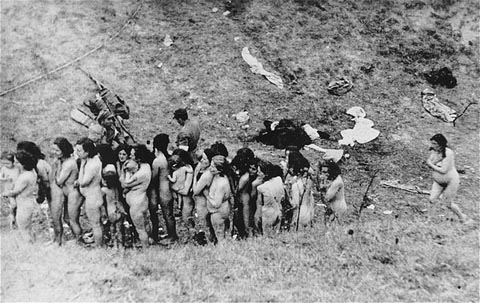
Naked Jewish women, some of whom are holding infants, wait in a line before their execution by Ukrainian auxilliary police. (October 14, 1942)
|
September 4, 2000 |
 |
| Photograph from the Main Commission for the Investigation of Nazi War Crimes, courtesy of USHMM Photo Archives. Naked Jewish women, some of whom are holding infants, wait in a line before their execution by Ukrainian auxilliary police. (October 14, 1942) |

|
| The same image as above, but shown at the full 480 pixel width at which it was scanned. |
| First in line, mother and daughter looking forward. | Girl of about 7 years standing on the ground clinging to her mother. | Infant held facing backward, mother's hand cradling its head. | Little girl sitting on her mother's forearm. | Possibly visible is the back of a baby's head, where the baby is facing to the right, toward the back of the line. |
| Man with white armband facing left. |
| Man with military hat facing right, and possibly one other. |
| Unusually tall and thin woman with pigtails who could be 20 years old occupies the middle of the photograph fragment above. Immediately in front of her are visible the legs of a girl who might be about 10. | Perhaps a young woman. Higher resolution would help. |